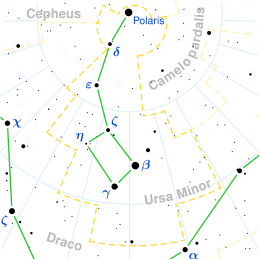Zeta Ursae Minoris
Zeta Ursae Minoris (ζ UMi, ζ Ursae Minoris) is a star in the constellation Ursa Minor. It is a white stellar class A-type main sequence star with an apparent magnitude of +4.28.[7] It is approximately 380 light years from Earth.
 | |
| Observation data Epoch J2000 Equinox J2000 | |
|---|---|
| Constellation | Ursa Minor |
| Right ascension | 15h 44m 03.5193s[1] |
| Declination | +77° 47′ 40.175″[1] |
| Apparent magnitude (V) | +4.32[2] |
| Characteristics | |
| Spectral type | A3Vn[3] |
| U−B color index | +0.05[2] |
| B−V color index | +0.04[2] |
| Astrometry | |
| Radial velocity (Rv) | –13.1[4] km/s |
| Proper motion (μ) | RA: 20.07[1] mas/yr Dec.: –2.50[1] mas/yr |
| Parallax (π) | 8.68 ± 0.47[1] mas |
| Distance | 380 ± 20 ly (115 ± 6 pc) |
| Absolute magnitude (MV) | −0.98[5] |
| Details | |
| Luminosity | 227[5] L☉ |
| Other designations | |
| Database references | |
| SIMBAD | data |
Despite its classification as a main sequence dwarf star, Zeta UMi is 3.4 times the mass of the sun and its luminosity is about 200 solar luminosities. At a surface temperature of 8,700 kelvins, this star is actually on the verge of becoming a giant star. Zeta UMi may also be a variable of the Delta Scuti type.[8]
In some Arabic star charts it is listed as أخفى الفرقدين ʼakhfā al-farqadayn, meaning "the dimmer of the two calves", and paired with η Ursae Minoris as ʼanwar al-farqadayn, "the brighter of the two calves". The names may originally refer to a pair of Ibexes, and are more properly applied to γ UMi and β UMi respectively, the brighter two stars in the rectangle of Ursa Minor.[9]
References
- Perryman, M. A. C.; et al. (1997), "The Hipparcos Catalogue", Astronomy & Astrophysics, 323: L49–L52, Bibcode:1997A&A...323L..49P
- Johnson, H. L.; et al. (1966). "UBVRIJKL photometry of the bright stars". Communications of the Lunar and Planetary Laboratory. 4 (99). Bibcode:1966CoLPL...4...99J.
- Cowley, A.; Cowley, C.; Jaschek, M.; Jaschek, C. (April 1969). "A study of the bright A stars. I. A catalogue of spectral classifications". Astronomical Journal. 74: 375–406. Bibcode:1969AJ.....74..375C. doi:10.1086/110819.
- Evans, D. S. (June 20–24, 1966). "The Revision of the General Catalogue of Radial Velocities". In Batten, Alan Henry; Heard, John Frederick (eds.). Determination of Radial Velocities and their Applications, Proceedings from IAU Symposium no. 30. University of Toronto: International Astronomical Union. Bibcode:1967IAUS...30...57E.
- Anderson, E.; Francis, Ch. (2012), "XHIP: An extended hipparcos compilation", Astronomy Letters, 38 (5): 331, arXiv:1108.4971, Bibcode:2012AstL...38..331A, doi:10.1134/S1063773712050015.
- "NSV 7263 – Variable Star". SIMBAD. Centre de Données astronomiques de Strasbourg. Retrieved 2009-10-28.
- "Zeta Ursae Minoris - Variable Star". SIMBAD Astronomical Database. Centre de Données astronomiques de Strasbourg. Retrieved 21 June 2014.
- Kaler, James B. "Alifa al Farkadain". Stars. University of Illinois. Retrieved 21 June 2014.
- Richard Hinckley Allen (1899). Star-names and Their Meanings. G.E. Stechert. pp. 447–460.